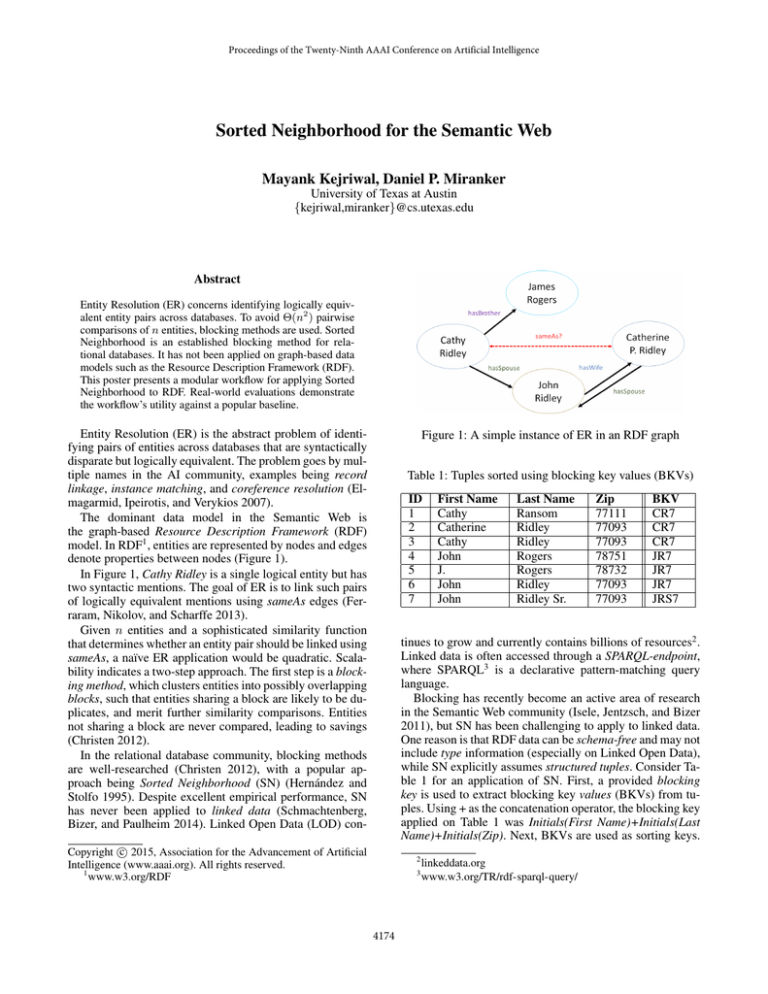
Proceedings of the Twenty-Ninth AAAI Conference on Artificial Intelligence
Sorted Neighborhood for the Semantic Web
Mayank Kejriwal, Daniel P. Miranker
University of Texas at Austin
{kejriwal,miranker}@cs.utexas.edu
Abstract
Entity Resolution (ER) concerns identifying logically equivalent entity pairs across databases. To avoid Θ(n2 ) pairwise
comparisons of n entities, blocking methods are used. Sorted
Neighborhood is an established blocking method for relational databases. It has not been applied on graph-based data
models such as the Resource Description Framework (RDF).
This poster presents a modular workflow for applying Sorted
Neighborhood to RDF. Real-world evaluations demonstrate
the workflow’s utility against a popular baseline.
Entity Resolution (ER) is the abstract problem of identifying pairs of entities across databases that are syntactically
disparate but logically equivalent. The problem goes by multiple names in the AI community, examples being record
linkage, instance matching, and coreference resolution (Elmagarmid, Ipeirotis, and Verykios 2007).
The dominant data model in the Semantic Web is
the graph-based Resource Description Framework (RDF)
model. In RDF1 , entities are represented by nodes and edges
denote properties between nodes (Figure 1).
In Figure 1, Cathy Ridley is a single logical entity but has
two syntactic mentions. The goal of ER is to link such pairs
of logically equivalent mentions using sameAs edges (Ferraram, Nikolov, and Scharffe 2013).
Given n entities and a sophisticated similarity function
that determines whether an entity pair should be linked using
sameAs, a naı̈ve ER application would be quadratic. Scalability indicates a two-step approach. The first step is a blocking method, which clusters entities into possibly overlapping
blocks, such that entities sharing a block are likely to be duplicates, and merit further similarity comparisons. Entities
not sharing a block are never compared, leading to savings
(Christen 2012).
In the relational database community, blocking methods
are well-researched (Christen 2012), with a popular approach being Sorted Neighborhood (SN) (Hernández and
Stolfo 1995). Despite excellent empirical performance, SN
has never been applied to linked data (Schmachtenberg,
Bizer, and Paulheim 2014). Linked Open Data (LOD) con-
Figure 1: A simple instance of ER in an RDF graph
Table 1: Tuples sorted using blocking key values (BKVs)
ID
1
2
3
4
5
6
7
First Name
Cathy
Catherine
Cathy
John
J.
John
John
Last Name
Ransom
Ridley
Ridley
Rogers
Rogers
Ridley
Ridley Sr.
Zip
77111
77093
77093
78751
78732
77093
77093
BKV
CR7
CR7
CR7
JR7
JR7
JR7
JRS7
tinues to grow and currently contains billions of resources2 .
Linked data is often accessed through a SPARQL-endpoint,
where SPARQL3 is a declarative pattern-matching query
language.
Blocking has recently become an active area of research
in the Semantic Web community (Isele, Jentzsch, and Bizer
2011), but SN has been challenging to apply to linked data.
One reason is that RDF data can be schema-free and may not
include type information (especially on Linked Open Data),
while SN explicitly assumes structured tuples. Consider Table 1 for an application of SN. First, a provided blocking
key is used to extract blocking key values (BKVs) from tuples. Using + as the concatenation operator, the blocking key
applied on Table 1 was Initials(First Name)+Initials(Last
Name)+Initials(Zip). Next, BKVs are used as sorting keys.
c 2015, Association for the Advancement of Artificial
Copyright Intelligence (www.aaai.org). All rights reserved.
1
www.w3.org/RDF
2
3
4174
linkeddata.org
www.w3.org/TR/rdf-sparql-query/
Figure 3: Results on the Video Game benchmark
Figure 2: A linked data Sorted Neighborhood workflow
spectively measure efficiency and effectiveness of blocking
(Christen 2012).
In the expanded work, we also show results from two
other real-world test cases. Qualitatively, these results
demonstrate that the workflow can adapt gracefully to RDF
and that SN benefits need not be restricted merely to the tabular domain. In future work, we will investigate extensions
of the workflow, as well as a MapReduce implementation.
Finally, a window of (pre-determined) constant size w is slid
over the sorted tuples. Entities sharing a window are paired
with each other and become candidates for further evaluation. Typical values of w range from 2 to 10. Assuming
w << n, the sorting cost is found to dominate SN run-time
(Hernández and Stolfo 1995).
SN is considered state-of-the-art among relational practitioners, owing to its excellent performance. New SN variants continue to be researched and evaluated, but are limited
to relational databases (Draisbach and Naumann 2009). One
possible reason why linked data has proved to be a challenging application for SN is because it is distributed, with
many datasets only accessible using SPARQL. As such, it is
not evident how to operationalize SN for such data.
An SN workflow that can operate on linked data available either as downloadable dumps or through a SPARQL
endpoint is presented in Figure 2. The full technical details
are in an expanded work4 . First, we propose a specific class
of blocking keys called property-specific blocking keys. This
class of blocking keys is schema-agnostic and may be applied on semi-structured graph data rather than structured
tuples. Intuitively, these keys treat the properties of an RDF
graph like the columns of a table. An example (on Figure
1) would be Tokens(hasSpouse)+Initials(Name). The keys
can be framed in terms of a SPARQL query if the data is
not available as a dump. If it is, a linear-time algorithm is
executed. The output of either option is a set of looselystructured tuples on which the property-specific blocking
key B can operate to produce BKVs. By virtue of a slidingwindow process, a candidate set of promising entity-entity
pairs can be populated and input to the second ER step. The
workflow offers options to data publishers and administrators to publish intermediate outputs in the form of thirdparty triples. Such triples can be used as a cache to appropriately distribute the load for large datasets, for example.
In Figure 3, experimental results from the Video Game
benchmark are provided. This benchmark contains over
230,000 triples, and is real-world. The proposed method
is shown to outperform an established clustering baseline,
Canopies (McCallum, Nigam, and Ungar 2000). Reduction
Ratio and Pairs Completeness are standard metrics that re-
References
Christen, P. 2012. A survey of indexing techniques for scalable record linkage and deduplication. Knowledge and Data
Engineering, IEEE Transactions on 24(9):1537–1555.
Draisbach, U., and Naumann, F. 2009. A comparison
and generalization of blocking and windowing algorithms
for duplicate detection. In Proceedings of the International
Workshop on Quality in Databases (QDB), 51–56.
Elmagarmid, A. K.; Ipeirotis, P. G.; and Verykios, V. S.
2007. Duplicate record detection: A survey. Knowledge and
Data Engineering, IEEE Transactions on 19(1):1–16.
Ferraram, A.; Nikolov, A.; and Scharffe, F. 2013. Data
linking for the semantic web. Semantic Web: Ontology and
Knowledge Base Enabled Tools, Services, and Applications
169.
Hernández, M. A., and Stolfo, S. J. 1995. The merge/purge
problem for large databases. In ACM SIGMOD Record, volume 24, 127–138. ACM.
Isele, R.; Jentzsch, A.; and Bizer, C. 2011. Efficient multidimensional blocking for link discovery without losing recall.
In WebDB.
McCallum, A.; Nigam, K.; and Ungar, L. H. 2000. Efficient clustering of high-dimensional data sets with application to reference matching. In Proceedings of the sixth ACM
SIGKDD international conference on Knowledge discovery
and data mining, 169–178. ACM.
Schmachtenberg, M.; Bizer, C.; and Paulheim, H. 2014.
Adoption of the linked data best practices in different topical domains. In The Semantic Web–ISWC 2014. Springer.
245–260.
4
https://sites.google.com/a/utexas.edu/mayank-kejriwal/
projects/sorted-neighborhood
4175





